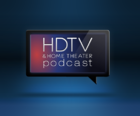 Apr 15
Apr 15 Podcast #735: THX tune-up to the Rescue
 Podcast Tags:
Podcast Tags:  4K,
4K,  Calibration,
Calibration,  THX,
THX,  UHD
UHD  We had a friend recently who was complaining about their HDTV experience at home. They weren’t seeing the quality they were hoping to see after upgrading their TV, and were contemplating returning it. In talking through it with them, we were able to convince them that perhaps the TV settings just needed to be dialed in to look great in their viewing room. They didn’t want to spend money on a professional calibration, so we went to the trusty THX tune-up app to see what we could do.
We had a friend recently who was complaining about their HDTV experience at home. They weren’t seeing the quality they were hoping to see after upgrading their TV, and were contemplating returning it. In talking through it with them, we were able to convince them that perhaps the TV settings just needed to be dialed in to look great in their viewing room. They didn’t want to spend money on a professional calibration, so we went to the trusty THX tune-up app to see what we could do.
| Download this Episode. |
Support the show with Patreon!
Listen to the show
Today's Show:
News:
- Dish Adds 4K Netflix To Hopper 3 DVR
- Cablevision integrates Hulu as native channel
- Home automation to be a $21.6B market in 4 years
- Hi-res audio attracts consumer attention
- Will 4K content catch up with 4K TVs?
- UHD Alliance to add 4K certification logos to Blu-ray players
Other:
- Best show about woodworking: Wood Talk. Or visit:TheWoodWhisperer.com
- Vizio Pulls the Plug on Free TV
- Layer3 TV’s Crazy Plan to Take on Comcast and Reinvent Cable
Amazon Prime:
Sign up for Amazon Prime and enjoy:
- Free Two Day Shipping!
- Instant Streaming of TV Shows and Movies
- Instant Access to thousands of Kindle Books
- The HT Guys gratitude!
We had a friend recently who was complaining about their HDTV experience at home. They weren’t seeing the quality they were hoping to see after upgrading their TV, and were contemplating returning it. In talking through it with them, we were able to convince them that perhaps the TV settings just needed to be dialed in to look great in their viewing room. They didn’t want to spend money on a professional calibration, so we went to the trusty THX tune-up app to see what we could do. If you don’t have THX tune-up, you should get it. We ran the iOS version for this exercise, but they also have an Android version as well. Both are free, so you spend a few seconds downloading and installing it and away you go. We can talk through the specific on setting up the iOS app, because it’s the one we used, but many of the setup steps are the same. The basics are: install the app, launch it, connect it to your TV or AVR. On iOS you can connect it with HDMI or AirPlay. The app tells you that: “THX tune-up uses both your mobile device screen and your HDTV screen, making this an interactive 2nd screen application.” Of course you would assume that to calibrate the screen the app would need to put images on it. You can’t calibrate it just by looking at pictures on the phone. We used HDMI to connect to the TV, which for iOS requires an AV adapter. Apple sells them for the lightning adapter and the old school 30 pin connector, so no matter what iOS device you have, you’re covered. We used HDMI because we had the adapter and because HDMI allows you to test audio as well. We didn’t need the audio portion for this time, but if you want to get the full experience out of the app, picking up the adapter so you can connect with HDMI is the way to go. In this case a simple AirPlay mirroring would have worked great for calibrating the screen. So in a pinch, if you just want to dial in display settings, take an AppleTV with you to your friend’s house and you’ll be all set. There is an app setup step that allows you to tell the app what kind of equipment: Television, Projector, Receiver, etc. you’re connected to. It is optional, but supposedly it could help dial in the tests for your particular gear. Use it if you want, skip it if you don’t care. It really doesn't matter all the much. Once you get setup, you can play the THX deep note through your system for giggles. It’s a pretty cool way to demo your setup, but probably a bit janky to pull out the app just for that. If you hit the ‘Get Started’ button on the home screen of the app it will play a short video that describes most of the test you can run and what the app will be doing to optimize your home theater experience. It describes the various picture adjustments and what you’ll be doing to get them dialed in just right. Again, this step is totally optional. If you’re new to TV settings and options, it’s a cool primer on what you’re about to do. If you are already familiar with the concepts of brightness, contrast, etc. you can skip it. Just jump directly to the ‘Adjustments’ are of the app. We know this isn’t a real calibration, and we’ll probably get a few emails from the community on it, but there’s just not a better word for use for it. Call it ‘TV setting optimization’ if you like, but for simplicity we’re going to call it calibration. The app has five picture adjustment tests and two audio settings tests, each in their own menu. We didn’t use the audio tests this time, but we’ll talk about them in a bit for completeness. In our case we walked through the Picture Adjustment options because that was all we really cared about. The Picture Adjustment setting choices are: Aspect Ratio, Brightness, Contrast, Color, and Tint with a final option called ‘Review Adjustments’ that allows you to review all the setting changes you made with different images/patterns to make sure they all worked as expected. The Aspect Ratio setting shows a pattern to make sure you’re seeing enough of the screen and that shapes are the correct size.This eliminates issues with stretching and overscan. There’s a circle in the middle of the pattern that quickly shows you if you’re dealing with and stretching or distortion issues. Moving on from Aspect Ratio, you dive into Brightness. This make sure your screen isn’t too dark. You want the screen to be as dark as possible without losing shadow detail or other parts of a dark image. From there you dial in Contrast. Contrast and Brightness are similar, but also quite different. You use Brightness to make sure you can see details in dark images. Contrast makes sure you can see white detail. You want to be able to see slight variations even in white images. With these two dialed in, the subtle details in your images should be much more visible. Now that you have dark and light dialed in, next you move on to Color. The color adjustment is used to make sure the colors on your TV are light and vibrant but don’t look fake or cartoonish. For this one you need to use the camera to enable the red filter and then look through the phone at the image on your TV. This is actually a really cool way to dial in the color. For many calibration options you get a thin plastic film, either a red or blue filter, to do the same thing. But those are easy to lose or damage. The tint adjustment makes sure skin tones look good. THX recommends you don’t adjust tint, saying that most TVs should stay right in the middle for tint. But the app does have a test you can run to make sure the middle is the right setting for you. Again this test uses your phone camera with the red filter to get things set correctly. We ended up not changing tint at all. The last option in the Picture Settings menu is the ‘Review Adjustments’ option. It shows a lot of the same patterns you saw before, all on one screen, and a new test image with a little bit of everything. The test image has a spherical object you can use to test stretching or distortion, some dark areas for shadow detail or brightness, some white clouds to test white color variations or contrast, and a bunch of bright, vivid colors to check color and tint. If you’re happy with it, you’re done. The sound adjustment options in the app are Speaker Assignment and Speaker Phase. Assignment helps you make sure the intended sound is played through the intended speaker. The app can test 5.1 or stereo. It doesn't test 7.1 or anything more advanced. The Speaker Phase test allows you to determine accurately where a sound is coming from. If the speakers are out of phase, the test signals are harder to localize. This is a great test to run to make sure you wired everything up correctly. The THX tune-up app is a great addition to your arsenal as a friendly HDTV expert for friends and family. It certainly isn’t a match for a professional calibration, but it’s great for a quick tune up for all those secondary TVs you have around the house. The picture settings are where the app really shines, so even if you don’t have surround sound with those other TVs, the app still adds great value. For our friend, the TV absolutely looked better after running it through the app, but he still wasn’t satisfied...unless we were streaming 4k from Netflix. For him, it could be an issue with the quality of his 1080/720 content from his provider, or a scaling limitation in the TV. Either way, he has to live with it or decide it’s just too early for him to get into the 4k game.THX tune-up to the Rescue
Install and Setup
Calibration
Picture
Sound
Conclusion


Reader Comments (2)
My finance committee would never approve the purchase of a TV without an OTA tuner. We need that option in case DirecTV has problems during the committee's favorite shows.
Re: "TV" without a tuner
I'm also conflicted about this.
Ever since the local cable had gone all digital (October 2012), I haven't used the tuners in my TVs. (The cable box, Blu-ray player, the Roku I keep on thinking I'll buy to replace my first-generation Roku, and even my first-generation Roku all have an HDMI port.)
On the other hand, on my last TV purchase there are only two ways to get an analog signal into the TV: (1) through the combined composite/component port, and (2) through the tuner (most modern TV tuners will accept the old analog NTSC channels as well as the new digital ATSC channels). This can be an issue if I get more than two legacy devices that have analog outputs.
Then there is the issue of what would happen if I decide to sell or give away a tunerless display. Technically, it can't be called a TV (the FCC has declared that if it is called a "TV" it must do TV-like things, like receive over-the-air TV signals), and that makes it a bit less recognizable if I try to sell it. And with the dearth of legacy ports (the only analog port on the Vizio P series is one combined composite/component port) the TV won't have that much appeal to households that have legacy equipment and definitely not where the only outputs are RF modulated (typically NTSC channel 3 or 4). And I have seen posts in AVSFORUM where some people use an antenna for local stations for the better PQ and a pay service for other channels and, again, without a tuner the TV would be less appealing.
I have seen speculation that a built-in tuner would add about $10 to the manufacturing costs. I would probably pay $50 more for a tuner, so the TV has to be that much greater in value than an equivalently priced unit with a tuner.